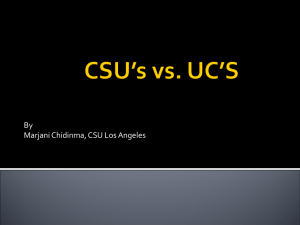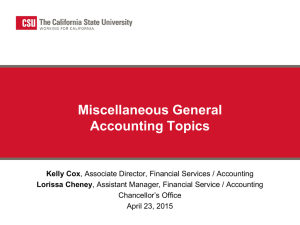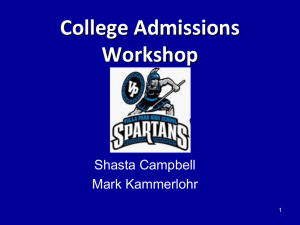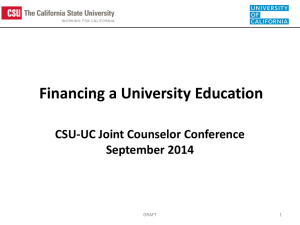Proposing New CSU Degree Programs Bachelor`s and Master`s
advertisement
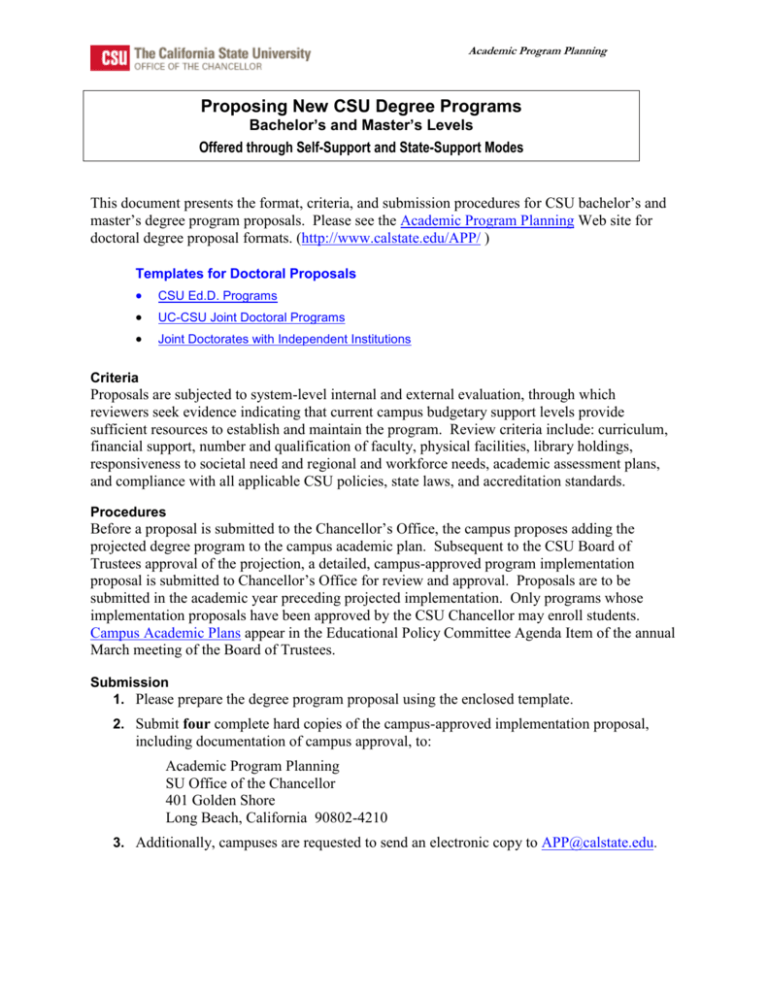
Academic Program Planning Proposing New CSU Degree Programs Bachelor’s and Master’s Levels Offered through Self-Support and State-Support Modes This document presents the format, criteria, and submission procedures for CSU bachelor’s and master’s degree program proposals. Please see the Academic Program Planning Web site for doctoral degree proposal formats. (http://www.calstate.edu/APP/ ) Templates for Doctoral Proposals CSU Ed.D. Programs UC-CSU Joint Doctoral Programs Joint Doctorates with Independent Institutions Criteria Proposals are subjected to system-level internal and external evaluation, through which reviewers seek evidence indicating that current campus budgetary support levels provide sufficient resources to establish and maintain the program. Review criteria include: curriculum, financial support, number and qualification of faculty, physical facilities, library holdings, responsiveness to societal need and regional and workforce needs, academic assessment plans, and compliance with all applicable CSU policies, state laws, and accreditation standards. Procedures Before a proposal is submitted to the Chancellor’s Office, the campus proposes adding the projected degree program to the campus academic plan. Subsequent to the CSU Board of Trustees approval of the projection, a detailed, campus-approved program implementation proposal is submitted to Chancellor’s Office for review and approval. Proposals are to be submitted in the academic year preceding projected implementation. Only programs whose implementation proposals have been approved by the CSU Chancellor may enroll students. Campus Academic Plans appear in the Educational Policy Committee Agenda Item of the annual March meeting of the Board of Trustees. Submission 1. Please prepare the degree program proposal using the enclosed template. 2. Submit four complete hard copies of the campus-approved implementation proposal, including documentation of campus approval, to: Academic Program Planning SU Office of the Chancellor 401 Golden Shore Long Beach, California 90802-4210 3. Additionally, campuses are requested to send an electronic copy to APP@calstate.edu. Academic Program Planning Code: AA-2007-2 Attachment A CSU Degree Program Proposal Template Please Note: 1. Campuses may mention proposed degree programs in recruitment material if it is specified that enrollment in the proposed program is contingent on final program authorization from the CSU Chancellor’s Office. Approved degree programs will be subject to campus program review within five years after implementation. Program review should follow system and Board of Trustee guidelines (including engaging outside evaluators) and should not rely solely on accreditation review. Program Type (Please specify any from the list below that apply—delete the others) State-Support Self-Support Online Program Fast Track Pilot Pilot Conversion Conversion of Self-Support to State-Support Program Elevation of Option or Concentration to a Full Degree Program New Program Proposal Revision (updating a previously reviewed proposal) 2. Program Identification a. Campus b. Full and exact degree designation and title (e.g. Master of Science in Genetic Counseling, Bachelor of Arts with a Major in History). c. Date the Board of Trustees approved adding this program projection to the campus Academic Plan. d. Term and academic year of intended implementation (e.g. Fall 2007). e. Name of the department(s), division, or other unit of the campus that would offer the proposed degree major program. Please identify the unit that will have primary responsibility. f. Name, title, and rank of the individual(s) primarily responsible for drafting the proposed degree major program. g. Statement from the appropriate campus administrative authority that the addition of this program supports the campus mission and will not impede the successful operation and 2 Code AA-2007-2 Attachment A APP@calstate.edu Academic Program Planning Code: AA-2007-2 Attachment A growth of existing academic programs. (CPEC “Appropriateness to Institutional and Segmental Mission”) h. Any other campus approval documents that may apply (e.g. curriculum committee approvals). 3. i. Please specify whether this proposed program is subject to WASC Substantive Change review. j. Optional: Proposed Classification of Instructional Programs (CIP) Code and CSU Degree Program Code Campuses are invited to suggest one CSU degree program code and one corresponding CIP code. If an appropriate CSU code does not appear on the systemwide list at: http://www.calstate.edu/app/documents/HEGIS-CIP2000_102406.xls , you can search CIP 2000 at http://nces.ed.gov/pubs2002/cip2000/ to identify the code that best matches the proposed degree program. The Classification of Instructional Programs (CIP) is a National Center for Education Statistics (NCES) publication that provides a numerical classification and standard terminology for secondary and postsecondary instructional programs. The CSU degree program code (based on old HEGIS codes) and CIP code will be assigned when the program is approved by the Chancellor. Program Overview and Rationale a. Rationale, including a brief description of the program, its purpose and strengths, fit with institutional mission, and a justification for offering the program at this time. The rationale may explain the relationship among the program philosophy, design, target population, and any distinctive pedagogical methods. (CPEC “Appropriateness to Institutional and Segmental Mission”) b. Proposed catalog description, including program description, degree requirements, and admission requirements. For master’s degrees, please also include catalog copy describing the culminating experience requirement(s). 4. Curriculum a. Goals for the (1) program and (2) student learning outcomes. Program goals are very broad statements about what the program is intended to achieve, including what kinds of graduates will be produced. Student learning outcomes are more specific statements that are related to the program goals but that more narrowly identify what students will know and be able to do upon successful completion of the program. b. Plans for assessing program goals and student learning outcomes. Some planners find it helpful to develop matrices in which student learning outcomes and required courses are mapped, indicating where content related to the learning outcomes is introduced, reinforced, and practiced at an advanced level in required courses. (CPEC “Maintenance and Improvement of Quality”) c. Total number of units required for the major. d. Include a justification for any baccalaureate program that requires more than 120-semester units or 180-quarter units. e. If any formal options, concentrations, or special emphases are planned under the proposed major, identify and explain fully. Optional: You may propose a CSU degree program code 3 Code AA-2007-2 Attachment A APP@calstate.edu Academic Program Planning Code: AA-2007-2 Attachment A and CIP code for each concentration that you would like to report separately from the major program, if the option is approximately equivalent to a degree currently listed on the CSU application-booklet degree program table. If you do not find an appropriate CSU degree program code at: http://www.calstate.edu/app/documents/HEGIS-CIP2000_102406.xls , you can search CIP 2000 at http://nces.ed.gov/pubs2002/cip2000/ to help identify the code that best matches the proposed curriculum. f. A list of all courses required for the major, specifying catalog number, title, units of credit, and prerequisites or co-requisites (ensuring that there are no “hidden” prerequisites that would drive the total units required to graduate beyond the total reported in 4c above). g. List of elective courses that can be used to satisfy requirements for the major, specifying catalog number, title, units of credit, and prerequisites or co-requisites. Include proposed catalog descriptions of all new courses. For graduate program proposals, identify whether each course is a graduate or undergraduate offering. Note: With regard to Sections 4f and 4g, a proposed program should take advantage of courses already offered in other departments when subject matter would have considerable overlapping content. h. List of any new courses that are: (1) needed to initiate the program and (2) needed during the first two years after implementation. Only include proposed catalog descriptions for new courses. For graduate program proposals, identify whether each course is a graduate-level or undergraduate-level offering. i. Attach a proposed course-offering plan for the first three years of program implementation, indicating, where possible, likely faculty teaching assignments. j. For master’s degree proposals, include evidence that program requirements conform to the minimum requirements for the culminating experience, as specified in Section 40510 of Title 5 of the California Code of Regulations. k. Admission criteria, including prerequisite coursework. l. Criteria for student continuation in the program. m. For undergraduate programs, planned provisions for articulation of the proposed major with community college programs. n. If there is a Lower-Division Transfer Pattern (LDTP) for this major, indicate the relationship between the LDTP and the requirements presented in this proposal. Information on LDTP is available at: http://www.calstate.edu/AcadAff/ldtp.shtml o. Advising “roadmaps” that have been developed for the major. p. Provision for meeting accreditation requirements, if applicable, and anticipated date of accreditation request (including the WASC Substantive Change process). Accreditation Note: Master’s degree program proposals If subject to accreditation, establishment of a master’s degree program should be preceded by national professional accreditation of the corresponding bachelor’s degree major program. (Accreditation note finished on next page.) 4 Code AA-2007-2 Attachment A APP@calstate.edu Academic Program Planning Code: AA-2007-2 Attachment A Fast-track proposals Fast-track proposals cannot be subject to specialized accreditation by an agency that is a member of the Association of Specialized and Professional Accreditors unless the proposed program is already offered as an authorized option or concentration that is accredited by an appropriate specialized accrediting agency. 5. Need for the Proposed Degree Major Program (CPEC “Societal Need,” “Number of Existing Programs in the Field,” and “Advancement of the Field”) a. List of other California State University campuses currently offering or projecting the proposed degree major program; list of neighboring institutions, public and private, currently offering the proposed degree major program. b. Differences between the proposed program and programs listed in Section 5a above. c. List of other curricula currently offered by the campus that are closely related to the proposed program. d. Community participation, if any, in the planning process. This may include prospective employers of graduates. e. Applicable workforce demand projections and other relevant data. f. If the program was proposed to meet society’s need for the advancement of knowledge, please specify the need and explain how the program meets that need. Note: Data Sources for Demonstrating Evidence of Need APP Resources Web http://www.calstate.edu/app/resources.shtml US Department of Labor, Bureau of Labor Statistics California Labor Market Information Labor Forecast 6. Student Demand (CPEC “Student Demand”) a. Compelling evidence of student interest in enrolling in the proposed program. Types of evidence vary and may include national, statewide, and professional employment forecasts and surveys; petitions; lists of related associate degree programs at feeder community colleges; reports from community college transfer centers; and enrollments from feeder baccalaureate programs, for example. b. Issues of access considered when planning this program. c. For master’s degree proposals, the number of declared undergraduate majors and the degree production over the preceding three years for the corresponding baccalaureate program, if there is one. d. Professional uses of the proposed degree program. 5 Code AA-2007-2 Attachment A APP@calstate.edu Academic Program Planning Code: AA-2007-2 Attachment A e. The expected number of majors in the year of initiation and three years and five years thereafter. The expected number of graduates in the year of initiation, and three years and five years thereafter. 7. Existing Support Resources for the Proposed Degree Major Program (CPEC “Total Costs of the Program”) Note: Sections 7 and 8 should be prepared in consultation with the campus administrators responsible for faculty staffing and instructional facilities allocation and planning. A statement from the responsible administrator(s) should be attached to the proposal assuring that such consultation has taken place. a. Faculty who would teach in the program, indicating rank, appointment status, highest degree earned, date and field of highest degree, professional experience, and affiliations with other campus programs. For master’s degrees, include faculty publications or curriculum vitae. Note: For all proposed graduate degree programs, a minimum of five full-time faculty members with the appropriate terminal degree should be on the program staff. (Code Memo EP&R 85-20) b. Space and facilities that would be used in support of the proposed program. c. A report provided by the campus Library, detailing resources available to support the program (discussion of subject areas, volume counts, periodical holdings, etc. are appropriate). d. Existing academic technology, equipment, and other specialized materials currently available. 8. Additional Support Resources Required (CPEC “Total Costs of the Program”) Note: If additional support resources will be needed to implement and maintain the program, a statement by the responsible administrator(s) should be attached to the proposal assuring that such resources will be provided. a. Any special characteristics of the additional faculty or staff support positions needed to implement the proposed program. b. The amount of additional lecture and/or laboratory space required to initiate and to sustain the program over the next five years. Indicate any additional special facilities that will be required. If the space is under construction, what is the projected occupancy date? If the space is planned, indicate campus-wide priority of the facility, capital outlay program priority, and projected date of occupancy. c. A report written in consultation with the campus librarian, indicating any additional library resources needed. Indicate the commitment of the campus either to purchase or borrow through interlibrary loan these additional resources. d. Additional academic technology, equipment, or specialized materials that will be (1) needed to implement the program and (2) needed during the first two years after initiation. Indicate the source of funds and priority to secure these resource needs. 6 Code AA-2007-2 Attachment A APP@calstate.edu Academic Program Planning Code: AA-2007-2 Attachment A Submit completed proposal packages to: APP@calstate.edu and Academic Program Planning CSU Office of the Chancellor 401 Golden Shore Long Beach, CA 90802-4210 Contact Academic Program Planning Dr. Christine Hanson Interim Dean Academic Program Planning Ms. Norma Warren Academic Programs Phone (562) 951-4672 Phone (562) 951-4722 Fax Fax (562) 951-4982 chanson@calstate.edu (562) 951-4982 nwarren@calstate.edu Academic Program Planning is on the Web http://www.calstate.edu/APP/ Contact Extended Education Dr. Edward McAleer State University Dean, Extended Education Phone (562) 951-4795 Fax (562) 951-4982 emcaleer@calstate.edu 7 Code AA-2007-2 Attachment A APP@calstate.edu


